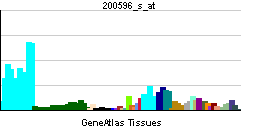EIF3A
| Eukaryotic translation initiation factor 3, subunit 10 theta, 150/170kDa | |||||||||||
|---|---|---|---|---|---|---|---|---|---|---|---|
| Identifiers | |||||||||||
| Symbols | EIF3S10 ; EIF3A; EIF3; KIAA0139; P167; eIF3-p170; eIF3-theta; p180; p185 | ||||||||||
| External IDs | Template:OMIM5 Template:MGI HomoloGene: 2779 | ||||||||||
| |||||||||||
| RNA expression pattern | |||||||||||
 | |||||||||||
 | |||||||||||
 | |||||||||||
| More reference expression data | |||||||||||
| Orthologs | |||||||||||
| Template:GNF Ortholog box | |||||||||||
| Species | Human | Mouse | |||||||||
| Entrez | n/a | n/a | |||||||||
| Ensembl | n/a | n/a | |||||||||
| UniProt | n/a | n/a | |||||||||
| RefSeq (mRNA) | n/a | n/a | |||||||||
| RefSeq (protein) | n/a | n/a | |||||||||
| Location (UCSC) | n/a | n/a | |||||||||
| PubMed search | n/a | n/a | |||||||||
Eukaryotic translation initiation factor 3, subunit 10 theta, 150/170kDa, also known as EIF3S10, is a human gene.[1]
References
Further reading
- Dong Z, Zhang JT (2006). "Initiation factor eIF3 and regulation of mRNA translation, cell growth, and cancer". Crit. Rev. Oncol. Hematol. 59 (3): 169–80. doi:10.1016/j.critrevonc.2006.03.005. PMID 16829125.
- Kanner SB, Reynolds AB, Vines RR, Parsons JT (1990). "Monoclonal antibodies to individual tyrosine-phosphorylated protein substrates of oncogene-encoded tyrosine kinases". Proc. Natl. Acad. Sci. U.S.A. 87 (9): 3328–32. PMID 2110361.
- Nagase T, Seki N, Tanaka A; et al. (1996). "Prediction of the coding sequences of unidentified human genes. IV. The coding sequences of 40 new genes (KIAA0121-KIAA0160) deduced by analysis of cDNA clones from human cell line KG-1". DNA Res. 2 (4): 167–74, 199–210. PMID 8590280.
- Méthot N, Song MS, Sonenberg N (1996). "A region rich in aspartic acid, arginine, tyrosine, and glycine (DRYG) mediates eukaryotic initiation factor 4B (eIF4B) self-association and interaction with eIF3". Mol. Cell. Biol. 16 (10): 5328–34. PMID 8816444.
- Asano K, Kinzy TG, Merrick WC, Hershey JW (1997). "Conservation and diversity of eukaryotic translation initiation factor eIF3". J. Biol. Chem. 272 (2): 1101–9. PMID 8995409.
- Méthot N, Rom E, Olsen H, Sonenberg N (1997). "The human homologue of the yeast Prt1 protein is an integral part of the eukaryotic initiation factor 3 complex and interacts with p170". J. Biol. Chem. 272 (2): 1110–6. PMID 8995410.
- Johnson KR, Merrick WC, Zoll WL, Zhu Y (1997). "Identification of cDNA clones for the large subunit of eukaryotic translation initiation factor 3. Comparison of homologues from human, Nicotiana tabacum, Caenorhabditis elegans, and Saccharomyces cerevisiae". J. Biol. Chem. 272 (11): 7106–13. PMID 9054404.
- Scholler JK, Kanner SB (1997). "The human p167 gene encodes a unique structural protein that contains centrosomin A homology and associates with a multicomponent complex". DNA Cell Biol. 16 (4): 515–31. PMID 9150439.
- Gradi A, Imataka H, Svitkin YV; et al. (1998). "A novel functional human eukaryotic translation initiation factor 4G". Mol. Cell. Biol. 18 (1): 334–42. PMID 9418880.
- Zhang Y, LeRoy G, Seelig HP; et al. (1998). "The dermatomyositis-specific autoantigen Mi2 is a component of a complex containing histone deacetylase and nucleosome remodeling activities". Cell. 95 (2): 279–89. PMID 9790534.
- Tong JK, Hassig CA, Schnitzler GR; et al. (1998). "Chromatin deacetylation by an ATP-dependent nucleosome remodelling complex". Nature. 395 (6705): 917–21. doi:10.1038/27699. PMID 9804427.
- Block KL, Vornlocher HP, Hershey JW (1998). "Characterization of cDNAs encoding the p44 and p35 subunits of human translation initiation factor eIF3". J. Biol. Chem. 273 (48): 31901–8. PMID 9822659.
- Ensinger C, Obrist P, Mikuz G; et al. (1999). "Assignment1 of the p150 subunit of the eukaryotic initiation factor 3A gene (EIF3A) to human chromosome band 10q26 by in situ hybridisation". Cytogenet. Cell Genet. 83 (1–2): 74–5. PMID 9925932.
- Zhang Y, Ng HH, Erdjument-Bromage H; et al. (1999). "Analysis of the NuRD subunits reveals a histone deacetylase core complex and a connection with DNA methylation". Genes Dev. 13 (15): 1924–35. PMID 10444591.
- Henis-Korenblit S, Strumpf NL, Goldstaub D, Kimchi A (2000). "A novel form of DAP5 protein accumulates in apoptotic cells as a result of caspase cleavage and internal ribosome entry site-mediated translation". Mol. Cell. Biol. 20 (2): 496–506. PMID 10611228.
- Humphrey GW, Wang Y, Russanova VR; et al. (2001). "Stable histone deacetylase complexes distinguished by the presence of SANT domain proteins CoREST/kiaa0071 and Mta-L1". J. Biol. Chem. 276 (9): 6817–24. doi:10.1074/jbc.M007372200. PMID 11102443.
- Lin L, Holbro T, Alonso G; et al. (2001). "Molecular interaction between human tumor marker protein p150, the largest subunit of eIF3, and intermediate filament protein K7". J. Cell. Biochem. 80 (4): 483–90. PMID 11169732.
- Pincheira R, Chen Q, Zhang JT (2001). "Identification of a 170-kDa protein over-expressed in lung cancers". Br. J. Cancer. 84 (11): 1520–7. doi:10.1054/bjoc.2001.1828. PMID 11384103.
- Saito M, Ishikawa F (2002). "The mCpG-binding domain of human MBD3 does not bind to mCpG but interacts with NuRD/Mi2 components HDAC1 and MTA2". J. Biol. Chem. 277 (38): 35434–9. doi:10.1074/jbc.M203455200. PMID 12124384.
- Strausberg RL, Feingold EA, Grouse LH; et al. (2003). "Generation and initial analysis of more than 15,000 full-length human and mouse cDNA sequences". Proc. Natl. Acad. Sci. U.S.A. 99 (26): 16899–903. doi:10.1073/pnas.242603899. PMID 12477932.
| This protein-related article is a stub. You can help Wikipedia by expanding it. |